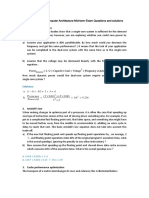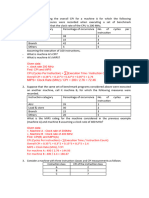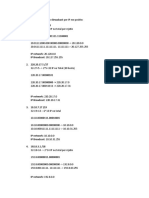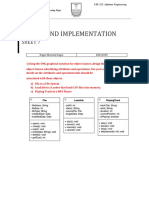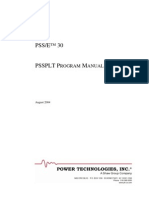Cache Lab
Cache Lab
Uploaded by
arteepu37022Copyright:
Available Formats
Cache Lab
Cache Lab
Uploaded by
arteepu37022Original Description:
Copyright
Available Formats
Share this document
Did you find this document useful?
Is this content inappropriate?
Copyright:
Available Formats
Cache Lab
Cache Lab
Uploaded by
arteepu37022Copyright:
Available Formats
CSCI-UA.
0201-003, Fall 2013 Cache Lab: Understanding Cache Memories
Logistics
This is an individual project. All handins are electronic. Download the handout from: http://cs.nyu.edu/courses/fall13/CSCI-UA.0201-003/cachelab-handout.tar
Overview
This lab will help you understand the impact that cache memories can have on the performance of your C programs. The lab consists of two parts. In the rst part you will write a small C program (about 200-300 lines) that simulates the behavior of a cache memory. In the second part, you will optimize a small matrix transpose function, with the goal of minimizing the number of cache misses.
Downloading the assignment
First, open and login to the virtual machine. Open a terminal and type: sudo apt-get install valgrind It will ask you about the root password, which is the same as the login password. Start by copying cachelab-handout.tar to a protected Linux directory in which you plan to do your work. Then give the command linux> tar -xvf cachelab-handout.tar This will create a directory called cachelab-handout that contains a number of les. You will be modifying two les: csim.c and trans.c. To compile these les, type: linux> make clean linux> make 1
WARNING: Do not let the Windows WinZip program open up your .tar le (many Web browsers are set to do this automatically). Instead, save the le to your Linux directory and use the Linux tar program to extract the les. In general, for this class you should NEVER use any platform other than Linux to modify your les. Doing so can cause loss of data (and important work!).
Description
The lab has two parts. In Part A you will implement a cache simulator. In Part B you will write a matrix transpose function that is optimized for cache performance.
4.1
Reference Trace Files
The traces subdirectory of the handout directory contains a collection of reference trace les that we will use to evaluate the correctness of the cache simulator you write in Part A. The trace les are generated by a Linux program called valgrind. For example, typing linux> valgrind --log-fd=1 --tool=lackey -v --trace-mem=yes ls -l on the command line runs the executable program ls -l, captures a trace of each of its memory accesses in the order they occur, and prints them on stdout. Valgrind memory traces have the following form: I 0400d7d4,8 M 0421c7f0,4 L 04f6b868,8 S 7ff0005c8,8 Each line denotes one or two memory accesses. The format of each line is [space]operation address,size The operation eld denotes the type of memory access: I denotes an instruction load, L a data load, S a data store, and M a data modify (i.e., a data load followed by a data store). There is never a space before each I. There is always a space before each M, L, and S. The address eld species a 64-bit hexadecimal memory address. The size eld species the number of bytes accessed by the operation.
4.2
Part A: Writing a Cache Simulator
In Part A you will write a cache simulator in csim.c that takes a valgrind memory trace as input, simulates the hit/miss behavior of a cache memory on this trace, and outputs the total number of hits, misses, and evictions. 2
We have provided you with the binary executable of a reference cache simulator, called csim-ref, that simulates the behavior of a cache with arbitrary size and associativity on a valgrind trace le. It uses the LRU (least-recently used) replacement policy when choosing which cache line to evict. The reference simulator takes the following command-line arguments: Usage: ./csim-ref [-hv] -s <s> -E <E> -b <b> -t <tracefile> -h: Optional help ag that prints usage info -v: Optional verbose ag that displays trace info -s <s>: Number of set index bits (S = 2s is the number of sets) -E <E>: Associativity (number of lines per set) -b <b>: Number of block bits (B = 2b is the block size) -t <tracefile>: Name of the valgrind trace to replay The command-line arguments are based on the notation (s, E , and b) from page 597 of the CS:APP2e textbook. For example: linux> ./csim-ref -s 4 -E 1 -b 4 -t traces/yi.trace hits:4 misses:5 evictions:3 The same example in verbose mode: linux> ./csim-ref -v -s 4 -E 1 -b 4 -t traces/yi.trace L 10,1 miss M 20,1 miss hit L 22,1 hit S 18,1 hit L 110,1 miss eviction L 210,1 miss eviction M 12,1 miss eviction hit hits:4 misses:5 evictions:3 Your job for Part A is to ll in the csim.c le so that it takes the same command line arguments and produces the identical output as the reference simulator. Notice that this le is almost completely empty. Youll need to write it from scratch.
Programming Rules for Part A
Include your name and loginID in the header comment for csim.c. Your csim.c le must compile without warnings in order to receive credit. Your simulator must work correctly for arbitrary s, E , and b. This means that you will need to allocate storage for your simulators data structures using the malloc function. Type man malloc for information about this function. For this lab, we are interested only in data cache performance, so your simulator should ignore all instruction cache accesses (lines starting with I). Recall that valgrind always puts I in the rst column (with no preceding space), and M, L, and S in the second column (with a preceding space). This may help you parse the trace. To receive credit for Part A, you must call the function printSummary, with the total number of hits, misses, and evictions, at the end of your main function: printSummary(hit_count, miss_count, eviction_count); For this this lab, you should assume that memory accesses are aligned properly, such that a single memory access never crosses block boundaries. By making this assumption, you can ignore the request sizes in the valgrind traces.
Some Hints About Part A
You have total freedom to implement your simulator in any way you want in csim.c, the only two restrictions are: to use printSummary() to print nal results, and to leave cachelab.h included in the le. For that part of the lab you dont need to worry about the content of cachelab.h.
4.3
Part B: Optimizing Matrix Transpose
In Part B you will write a transpose function in trans.c that causes as few cache misses as possible. Let A denote a matrix, and Aij denote the component on the ith row and jth column. The transpose of A, denoted AT , is a matrix such that Aij = AT ji . To help you get started, we have given you an example transpose function in trans.c that computes the transpose of N M matrix A and stores the results in M N matrix B : char trans_desc[] = "Simple row-wise scan transpose"; void trans(int M, int N, int A[N][M], int B[M][N])
The example transpose function is correct, but it is inecient because the access pattern results in relatively many cache misses. Your job in Part B is to write a similar function, called transpose_submit, that minimizes the number of cache misses across dierent sized matrices: char transpose_submit_desc[] = "Transpose submission"; void transpose_submit(int M, int N, int A[N][M], int B[M][N]); Do not change the description string (Transpose submission) for your transpose_submit function. The autograder searches for this string to determine which transpose function to evaluate for credit.
Programming Rules for Part B
Include your name and loginID in the header comment for trans.c. Your code in trans.c must compile without warnings to receive credit. You are allowed to dene at most 12 local variables of type int per transpose function.1 You are not allowed to side-step the previous rule by using any variables of type long or by using any bit tricks to store more than one value to a single variable. Your transpose function may not use recursion. If you choose to use helper functions, you may not have more than 12 local variables on the stack at a time between your helper functions and your top level transpose function. For example, if your transpose declares 8 variables, and then you call a function which uses 4 variables, which calls another function which uses 2, you will have 14 variables on the stack, and you will be in violation of the rule. Your transpose function may not modify array A. You may, however, do whatever you want with the contents of array B. You are NOT allowed to dene any arrays in your code or to use any variant of malloc.
Evaluation
This section describes how your work will be evaluated. The full score for this lab is 60 points: Part A: 27 Points Part B: 26 Points Style: 7 Points
1 The reason for this restriction is that our testing code is not able to count references to the stack. We want you to limit your references to the stack and focus on the access patterns of the source and destination arrays.
5.1
Evaluation for Part A
For Part A, we will run your cache simulator using dierent cache parameters and traces. There are eight test cases, each worth 3 points, except for the last case, which is worth 6 points: linux> linux> linux> linux> linux> linux> linux> linux> ./csim ./csim ./csim ./csim ./csim ./csim ./csim ./csim -s -s -s -s -s -s -s -s 1 4 2 2 2 2 5 5 -E -E -E -E -E -E -E -E 1 2 1 1 2 4 1 1 -b -b -b -b -b -b -b -b 1 4 4 3 3 3 5 5 -t -t -t -t -t -t -t -t traces/yi2.trace traces/yi.trace traces/dave.trace traces/trans.trace traces/trans.trace traces/trans.trace traces/trans.trace traces/long.trace
You can use the reference simulator csim-ref to obtain the correct answer for each of these test cases. During debugging, use the -v option for a detailed record of each hit and miss. For each test case, outputting the correct number of cache hits, misses and evictions will give you full credit for that test case. Each of your reported number of hits, misses and evictions is worth 1/3 of the credit for that test case. That is, if a particular test case is worth 3 points, and your simulator outputs the correct number of hits and misses, but reports the wrong number of evictions, then you will earn 2 points.
5.2
Evaluation for Part B
For Part B, we will evaluate the correctness and performance of your transpose_submit function on three dierent-sized output matrices: 32 32 (M = 32, N = 32) 64 64 (M = 64, N = 64) 61 67 (M = 61, N = 67) 5.2.1 Performance (26 pts)
For each matrix size, the performance of your transpose_submit function is evaluated by using valgrind to extract the address trace for your function, and then using the reference simulator to replay this trace on a cache with parameters (s = 5, E = 1, b = 5). Your performance score for each matrix size scales linearly with the number of misses, m, up to some threshold: 32 32: 8 points if m < 550, 0 points if m > 700 64 64: 8 points if m < 2, 700, 0 points if m > 3, 000 6
61 67: 10 points if m < 2, 800, 0 points if m > 3, 200 Your code must be correct to receive any performance points for a particular size. Your code only needs to be correct for these three cases and you can optimize it specically for these three cases. In particular, it is perfectly OK for your function to explicitly check for the input sizes and implement separate code optimized for each case.
5.3
Evaluation for Style
There are 7 points for coding style. These will be assigned manually by the course sta. The course sta will inspect your code in Part B for illegal arrays and excessive local variables.
6
6.1
Working on the Lab
Working on Part A
We have provided you with an autograding program, called test-csim, that tests the correctness of your cache simulator on the reference traces. Be sure to compile your simulator before running the test:
linux> make linux> ./test-csim Points 3 3 3 3 3 3 3 6 27 (s,E,b) (1,1,1) (4,2,4) (2,1,4) (2,1,3) (2,2,3) (2,4,3) (5,1,5) (5,1,5) Hits 9 4 2 167 201 212 231 265189 Your simulator Misses Evicts 8 6 5 2 3 1 71 67 37 29 26 10 7 0 21775 21743 Reference simulator Hits Misses Evicts 9 8 6 4 5 2 2 3 1 167 71 67 201 37 29 212 26 10 231 7 0 265189 21775 21743
traces/yi2.trace traces/yi.trace traces/dave.trace traces/trans.trace traces/trans.trace traces/trans.trace traces/trans.trace traces/long.trace
For each test, it shows the number of points you earned, the cache parameters, the input trace le, and a comparison of the results from your simulator and the reference simulator. Here are some hints and suggestions for working on Part A: Do your initial debugging on the small traces, such as traces/dave.trace. The reference simulator takes an optional -v argument that enables verbose output, displaying the hits, misses, and evictions that occur as a result of each memory access. You are not required to implement this feature in your csim.c code, but we strongly recommend that you do so. It will help you debug by allowing you to directly compare the behavior of your simulator with the reference simulator on the reference trace les. 7
We recommend that you use the getopt function to parse your command line arguments. Youll need the following header les: #include <getopt.h> #include <stdlib.h> #include <unistd.h> See man 3 getopt for details (or google it!). Each data load (L) or store (S) operation can cause at most one cache miss. The data modify operation (M) is treated as a load followed by a store to the same address. Thus, an M operation can result in two cache hits, or a miss and a hit plus a possible eviction.
6.2
Working on Part B
We have provided you with an autograding program, called test-trans.c, that tests the correctness and performance of each of the transpose functions that you have registered with the autograder. You can register up to 100 versions of the transpose function in your trans.c le. Each transpose version has the following form: /* Header comment */ char trans_simple_desc[] = "A simple transpose"; void trans_simple(int M, int N, int A[N][M], int B[M][N]) { /* your transpose code here */ } Register a particular transpose function with the autograder by making a call of the form: registerTransFunction(trans_simple, trans_simple_desc); in the registerFunctions routine in trans.c. At runtime, the autograder will evaluate each registered transpose function and print the results. Of course, one of the registered functions must be the transpose_submit function that you are submitting for credit: registerTransFunction(transpose_submit, transpose_submit_desc); See the default trans.c function for an example of how this works. The autograder takes the matrix size as input. It uses valgrind to generate a trace of each registered transpose function. It then evaluates each trace by running the reference simulator on a cache with parameters (s = 5, E = 1, b = 5). For example, to test your registered transpose functions on a 32 32 matrix, rebuild test-trans, and then run it with the appropriate values for M and N : 8
linux> make linux> ./test-trans -M 32 -N 32 Step 1: Evaluating registered transpose funcs for correctness: func 0 (Transpose submission): correctness: 1 func 1 (Simple row-wise scan transpose): correctness: 1 func 2 (column-wise scan transpose): correctness: 1 func 3 (using a zig-zag access pattern): correctness: 1 Step 2: Generating memory traces for registered transpose funcs. Step func func func func 3: Evaluating performance of registered transpose funcs (s=5, E=1, b=5) 0 (Transpose submission): hits:1766, misses:287, evictions:255 1 (Simple row-wise scan transpose): hits:870, misses:1183, evictions:1151 2 (column-wise scan transpose): hits:870, misses:1183, evictions:1151 3 (using a zig-zag access pattern): hits:1076, misses:977, evictions:945
Summary for official submission (func 0): correctness=1 misses=287
In this example, we have registered four dierent transpose functions in trans.c. The test-trans program tests each of the registered functions, displays the results for each, and extracts the results for the ocial submission. Here are some hints and suggestions for working on Part B. The test-trans program saves the trace for function i in le trace.fi.2 These trace les are invaluable debugging tools that can help you understand exactly where the hits and misses for each transpose function are coming from. To debug a particular function, simply run its trace through the reference simulator with the verbose option: linux> ./csim-ref -v -s 5 -E 1 -b 5 -t trace.f0 S 68312c,1 miss L 683140,8 miss L 683124,4 hit L 683120,4 hit L 603124,4 miss eviction S 6431a0,4 miss ... Since your transpose function is being evaluated on a direct-mapped cache, conict misses are a potential problem. Think about the potential for conict misses in your code, especially along the diagonal. Try to think of access patterns that will decrease the number of these conict misses. Blocking is a useful technique for reducing cache misses. See
2 Because valgrind introduces many stack accesses that have nothing to do with your code, we have ltered out all stack accesses from the trace. This is why we have banned local arrays and placed limits on the number of local variables.
http://csapp.cs.cmu.edu/public/waside/waside-blocking.pdf for more information.
6.3
Putting it all Together
We have provided you with a driver program, called ./driver.py, that performs a complete evaluation of your simulator and transpose code. This is the same program your instructor uses to evaluate your handins. The driver uses test-csim to evaluate your simulator, and it uses test-trans to evaluate your submitted transpose function on the three matrix sizes. Then it prints a summary of your results and the points you have earned. To run the driver, type: linux> ./driver.py
Handing in Your Work
Each time you type make in the cachelab-handout directory, the Makele creates a tarball, called userid-handin.tar, that contains your current csim.c and trans.c les. If you work on our virtual machine, the user will be org. So, before submitting the le to us, rename the le to be netID-handin.tar. For example, if your netID is m123 linux> mv org-handin.tar m123-handin.tar Then email the tar le to the grader. IMPORTANT: Do not create the handin tarball on a Windows or Mac machine, and do not handin les in any other archive format, such as .zip, .gzip, or .tgz les.
10
You might also like
- ServiceNow Contract Management - BookDocument30 pagesServiceNow Contract Management - BookAbhishek Mishra50% (2)
- Assignment 4Document3 pagesAssignment 4harichandanaNo ratings yet
- 6th Central Pay Commission Salary CalculatorDocument15 pages6th Central Pay Commission Salary Calculatorrakhonde100% (436)
- Agile2 ChandDocument2 pagesAgile2 ChandChandrasekaranan25% (69)
- Parallel Algorithm MergedDocument76 pagesParallel Algorithm Mergedtebade8363No ratings yet
- SAP GUI For Windows 800 Release NotesDocument17 pagesSAP GUI For Windows 800 Release Notesmskhan0327No ratings yet
- CSI 4142 - Winter 2017 - FinalDocument4 pagesCSI 4142 - Winter 2017 - FinalAmin Dhouib0% (1)
- Operating SystemsDocument5 pagesOperating Systemskp_phani3694284No ratings yet
- ParaphraseDocument51 pagesParaphrasevincent tekeyNo ratings yet
- Final CSI 4107 - 2009 SolutionDocument11 pagesFinal CSI 4107 - 2009 SolutionMerelup100% (1)
- The Tipping ProblemDocument26 pagesThe Tipping ProblemEsmael AdemNo ratings yet
- 5: Exercise On FC SAN Design: ScenarioDocument1 page5: Exercise On FC SAN Design: ScenarioMohit Gautam100% (2)
- Abstract Data Type List ADTDocument40 pagesAbstract Data Type List ADTAnonymous 04Gc05OeCNo ratings yet
- MidtermsolutionsDocument3 pagesMidtermsolutionsRajini GuttiNo ratings yet
- Chapter 4 (Processors and Memory Hierarchy)Document17 pagesChapter 4 (Processors and Memory Hierarchy)Kushal Sh100% (1)
- Homework 1Document18 pagesHomework 1Migurdia RoxyNo ratings yet
- AI - Experiment 6 - Alpha Beta PruningDocument6 pagesAI - Experiment 6 - Alpha Beta PruningAryaman GandhiNo ratings yet
- COA - Chapter # 7Document41 pagesCOA - Chapter # 7Set EmpNo ratings yet
- Solutions Ch4Document7 pagesSolutions Ch4Sangam JindalNo ratings yet
- Computer Organization Jan 2010Document2 pagesComputer Organization Jan 2010Prasad C MNo ratings yet
- Assignment 5 - OpenCL OptimizationsDocument2 pagesAssignment 5 - OpenCL OptimizationsAbdulahi Abebe100% (1)
- Processor OrganizationDocument55 pagesProcessor OrganizationMinoshini Fonseka100% (1)
- Operating Systems Lab Manual JNTUDocument9 pagesOperating Systems Lab Manual JNTUmannanabdulsattar100% (1)
- Case Study: Library Book Circulation System: N. L. Sarda I.I.T. BombayDocument89 pagesCase Study: Library Book Circulation System: N. L. Sarda I.I.T. BombayShraddha NaiduNo ratings yet
- E1 Lab 5 5 1 inDocument9 pagesE1 Lab 5 5 1 inArtyomSarseyevNo ratings yet
- Provim Rrjeta Vjeshte 2021 (1) LKDocument30 pagesProvim Rrjeta Vjeshte 2021 (1) LKrigersa ersaNo ratings yet
- Automated Policy Based ManagementDocument5 pagesAutomated Policy Based Managementchinmayamalik861100% (1)
- Address Decoder For PCDocument19 pagesAddress Decoder For PCseyfiNo ratings yet
- Iitd Exam Os SolutionDocument6 pagesIitd Exam Os SolutionRohit JoshiNo ratings yet
- SWE Sheet7 NaguiMostafa 20012069Document13 pagesSWE Sheet7 NaguiMostafa 20012069nagui.mostafaNo ratings yet
- MCS 012Document4 pagesMCS 012S.M. FarhanNo ratings yet
- Assignment - 1Document4 pagesAssignment - 1ZAEEM SULTAN KHAN0% (1)
- LAB Manual - PART A - PLSQLDocument8 pagesLAB Manual - PART A - PLSQLNafsNo ratings yet
- IBM Professional Certification Program: Study Guide SeriesDocument30 pagesIBM Professional Certification Program: Study Guide SeriesAbtNo ratings yet
- 8254 Timer/CounterDocument20 pages8254 Timer/CounterAyush DusejaNo ratings yet
- Chapter 2:instructions: Language of The ComputerDocument81 pagesChapter 2:instructions: Language of The ComputerGreen ChiquitaNo ratings yet
- Parallel Architecture ClassificationDocument41 pagesParallel Architecture ClassificationAbhishek singh0% (1)
- Space Complexity - Unit 1 - Part 2Document15 pagesSpace Complexity - Unit 1 - Part 2DanielNo ratings yet
- PH 4 QuizDocument119 pagesPH 4 Quizstudent1985100% (1)
- Loop or Cycle Workflow InformaticaDocument8 pagesLoop or Cycle Workflow InformaticazipzapdhoomNo ratings yet
- Department of Computer Science and Engineering 18Cs43: Operating Systems Lecture Notes (QUESTION & ANSWER)Document8 pagesDepartment of Computer Science and Engineering 18Cs43: Operating Systems Lecture Notes (QUESTION & ANSWER)Manas Hassija100% (1)
- Srs of CharityDocument35 pagesSrs of CharityPreethu GowdaNo ratings yet
- Report PIDDocument11 pagesReport PIDSaiman ShettyNo ratings yet
- Assingment #3Document20 pagesAssingment #3Fahad SiddiquiNo ratings yet
- DLD Lab Report 07Document11 pagesDLD Lab Report 07Muneeb ahmadNo ratings yet
- Worksheet 4-Input+OutputDocument5 pagesWorksheet 4-Input+OutputShiza SiddiqueNo ratings yet
- CSE325 OS Laboratory ManualDocument36 pagesCSE325 OS Laboratory ManualKanna ChowdaryNo ratings yet
- Cumulative 4-Bit AdderDocument2 pagesCumulative 4-Bit AdderSidhartha Sankar RoutNo ratings yet
- Slide 05 - Input and OutputDocument26 pagesSlide 05 - Input and OutputEffendyFooadNo ratings yet
- Eit Practical File (8719139)Document54 pagesEit Practical File (8719139)Adil Hassan Mir 8720105No ratings yet
- Day-2 Aggregate FunctionsDocument25 pagesDay-2 Aggregate FunctionsAshok DuraiNo ratings yet
- Numerical Question Based On Shift Reduce ParserDocument8 pagesNumerical Question Based On Shift Reduce Parseramarjeet2420No ratings yet
- DSP Lab ManualDocument53 pagesDSP Lab ManualAli AhmadNo ratings yet
- Module - 01 DSPDocument24 pagesModule - 01 DSPIOZEF1100% (1)
- Devops RecordDocument109 pagesDevops RecordPriya NeelamNo ratings yet
- ESwitching Lab 2.5.2 Answer Intructor's VersionDocument11 pagesESwitching Lab 2.5.2 Answer Intructor's VersionChris PecasalesNo ratings yet
- Heterogeneity in Parallel and Distributed SystemsDocument5 pagesHeterogeneity in Parallel and Distributed Systemssidrakhalid1357No ratings yet
- Software Engineering by SachinrajDocument8 pagesSoftware Engineering by Sachinrajsachinraj2100% (3)
- Lab Assignment Report: ECS 851 Data Warehousing and Data MiningDocument69 pagesLab Assignment Report: ECS 851 Data Warehousing and Data MiningAyush jainNo ratings yet
- TNE30009 Lab5Document4 pagesTNE30009 Lab5Zahin RahmanNo ratings yet
- CachelabDocument10 pagesCachelab张凡No ratings yet
- Spring 2018 Lab Assignment #4: Understanding Cache Memories Assigned: Apr. 25 Deadline: May 9, 04:59:59 PMDocument10 pagesSpring 2018 Lab Assignment #4: Understanding Cache Memories Assigned: Apr. 25 Deadline: May 9, 04:59:59 PMSohaib ChoudharyNo ratings yet
- Csapp Lab3Document7 pagesCsapp Lab3SamNo ratings yet
- Project - Cache Organization and Performance EvaluationDocument9 pagesProject - Cache Organization and Performance EvaluationadvifulNo ratings yet
- RdsDocument586 pagesRdsarteepu37022No ratings yet
- Bsa Internet Advancement (Scoutnet) Login: Roster of Scouts and Their Ranks, Merit Badges and AwardsDocument8 pagesBsa Internet Advancement (Scoutnet) Login: Roster of Scouts and Their Ranks, Merit Badges and Awardsarteepu37022No ratings yet
- To See All The Details That Are Visible On The Screen, Use The "Print" Link Next To The MapDocument2 pagesTo See All The Details That Are Visible On The Screen, Use The "Print" Link Next To The Maparteepu37022No ratings yet
- Map 4 PDFDocument2 pagesMap 4 PDFarteepu37022No ratings yet
- Map 5 PDFDocument2 pagesMap 5 PDFarteepu37022No ratings yet
- Price List For Apartments in Ansals Highland Park, Sector 103, Gurgaon, HaryanaDocument1 pagePrice List For Apartments in Ansals Highland Park, Sector 103, Gurgaon, Haryanaarteepu37022No ratings yet
- Map 1 PDFDocument2 pagesMap 1 PDFarteepu37022No ratings yet
- Wordpress in 1 Day Free Tutorial: by Sarah McharryDocument0 pagesWordpress in 1 Day Free Tutorial: by Sarah Mcharryarteepu37022No ratings yet
- Sun Glassfish Communications Server 2.0 Error Message ReferenceDocument376 pagesSun Glassfish Communications Server 2.0 Error Message Referencearteepu4No ratings yet
- Newyork English Language Arts Grade3 Book1Document16 pagesNewyork English Language Arts Grade3 Book1梁耀栋No ratings yet
- Managing The Pear Libraries in OpenxDocument2 pagesManaging The Pear Libraries in Openxarteepu37022No ratings yet
- ObjectDocument2 pagesObjectarteepu37022No ratings yet
- LintDocument532 pagesLintarteepu37022No ratings yet
- Arora-Class 11-Vol 2Document644 pagesArora-Class 11-Vol 2AZTECIANO SORCERER100% (1)
- Software BooksDocument2 pagesSoftware BooksJalajSrivastavaNo ratings yet
- Chapter 3.0 File Management & TypesDocument4 pagesChapter 3.0 File Management & TypesSuman JyotiNo ratings yet
- Web VPN & SSL VPN: CCIE Security Advanced Technologies ClassDocument9 pagesWeb VPN & SSL VPN: CCIE Security Advanced Technologies ClassEdison AcostaNo ratings yet
- AI-n-Chatbot-B2B ConversationsDocument9 pagesAI-n-Chatbot-B2B ConversationsBreylin CastilloNo ratings yet
- First and Follow Predictive Parser: Compiler DesignDocument13 pagesFirst and Follow Predictive Parser: Compiler DesignMd Saidur Rahman Kohinoor75% (8)
- Copam Manual PDFDocument50 pagesCopam Manual PDFondemandprintNo ratings yet
- Max 31856 Ev SysDocument11 pagesMax 31856 Ev SysVikrant1No ratings yet
- Project ReportDocument71 pagesProject Reportkingfaiz11No ratings yet
- List of Practicals BbaDocument4 pagesList of Practicals BbaRaaj AaryanNo ratings yet
- ClassPresentationSD224848LPushingRevittotheNextLevelAnIntrotoRevitPluginswithCJeremyGraham PDFDocument38 pagesClassPresentationSD224848LPushingRevittotheNextLevelAnIntrotoRevitPluginswithCJeremyGraham PDFTruels WissnethNo ratings yet
- Samiboy 1301@Document35 pagesSamiboy 1301@Samanta AugiarNo ratings yet
- PLTDocument202 pagesPLTFernando100% (1)
- DBMS Notes VTuDocument26 pagesDBMS Notes VTuSuggu S PrasadNo ratings yet
- Newsletter Title: Subtitle Text HereDocument2 pagesNewsletter Title: Subtitle Text HereSHAMEEN NOORNo ratings yet
- Full Stack Developer Resume Example TemplateDocument2 pagesFull Stack Developer Resume Example TemplateraghulsakaravarthiNo ratings yet
- Start and Shut Down A ComputerDocument2 pagesStart and Shut Down A ComputerGurpreet GabaNo ratings yet
- Software DeveloperDocument7 pagesSoftware DevelopersiddarthaetyalaNo ratings yet
- Total ViewDocument13 pagesTotal ViewvamshiNo ratings yet
- Sap Bods DetailsDocument2 pagesSap Bods DetailsKrishna PrasadNo ratings yet
- SIEMENS 1991 SIMATIC S5 S5 115F Programmable Controller Manual Volume 2 of 2Document396 pagesSIEMENS 1991 SIMATIC S5 S5 115F Programmable Controller Manual Volume 2 of 2penjualgasNo ratings yet
- FSD Objective Final PDFDocument1 pageFSD Objective Final PDFRG RAJNo ratings yet
- Commvault Basic Interview Questions & AnswersDocument8 pagesCommvault Basic Interview Questions & Answershher100% (1)
- Industrial Training Report DTDocument42 pagesIndustrial Training Report DTPrince KumarNo ratings yet
- NET Core - Xamarin Forms + Prism - Xamarin Classic + MVVM Cross (Leasing)Document402 pagesNET Core - Xamarin Forms + Prism - Xamarin Classic + MVVM Cross (Leasing)Henry Leandro Garcia Ospina100% (1)
- IBS - Syed Masood HADocument4 pagesIBS - Syed Masood HAakshay rao0% (1)
- Client Feedback Process Flow ChartDocument1 pageClient Feedback Process Flow ChartmapaeroNo ratings yet













